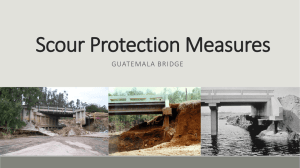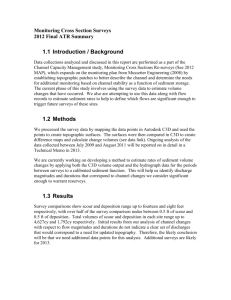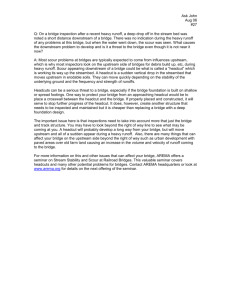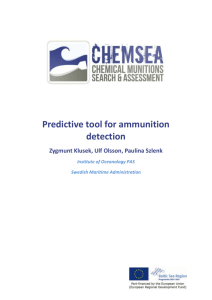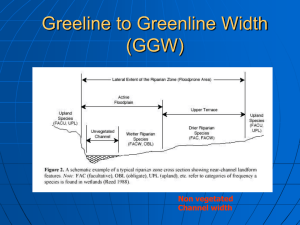- ePrints Soton
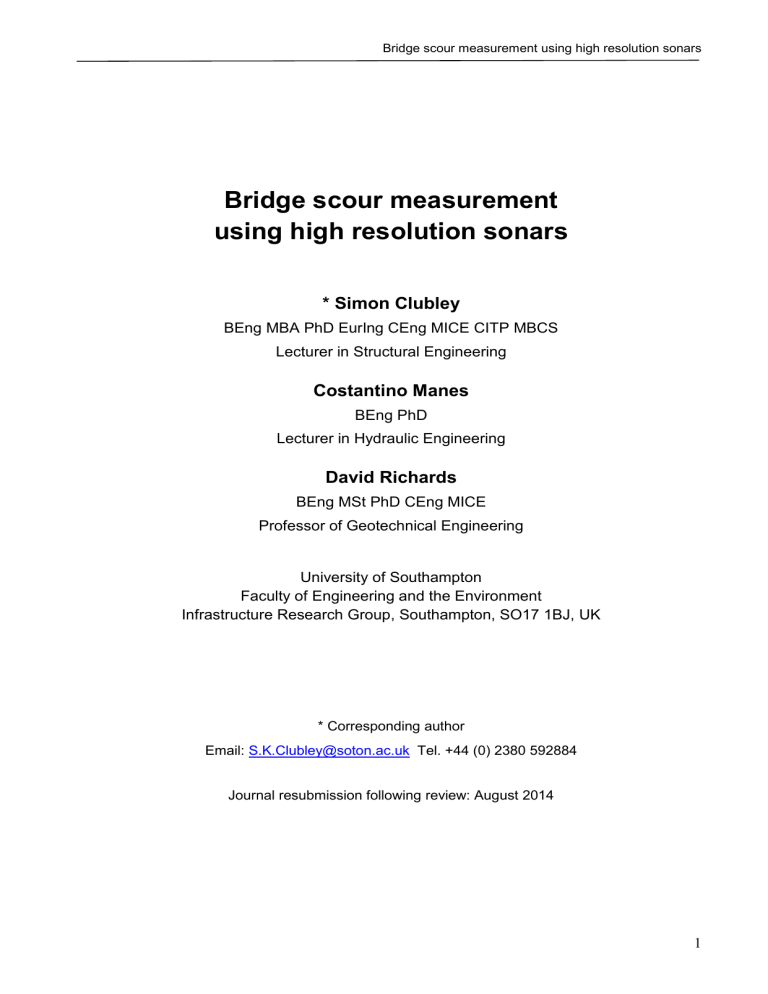
Bridge scour measurement using high resolution sonars
Bridge scour measurement using high resolution sonars
* Simon Clubley
BEng MBA PhD EurIng CEng MICE CITP MBCS
Lecturer in Structural Engineering
Costantino Manes
BEng PhD
Lecturer in Hydraulic Engineering
David Richards
BEng MSt PhD CEng MICE
Professor of Geotechnical Engineering
University of Southampton
Faculty of Engineering and the Environment
Infrastructure Research Group, Southampton, SO17 1BJ, UK
* Corresponding author
Email: S.K.Clubley@soton.ac.uk Tel. +44 (0) 2380 592884
Journal resubmission following review: August 2014
1
Bridge scour measurement using high resolution sonars
ABSTRACT
Described by the asset owner Network Rail as a potentially transformational change in infrastructure management, this paper presents the findings of a bridge scour trial inspection regime using state-of-the-art high resolution sonar and marine laser technologies. Following a period of laboratory familiarisation, a week long field study of the River Hamble Railway Viaduct in
Hampshire investigated the potential for wider civil engineering application. Three sonar systems were deployed in a progressive manner coupled with motion stabilised laser to produce a holistic assessment of the bridge structure above and below the waterline. A three-dimensional record of all scour erosion features was digitally mapped, together with the current in-service condition of the sub-structure. In this research, it is shown that diver inspection reports may be inaccurate or difficult to interpret. Furthermore, in the case of the River Hamble Viaduct, significant scour was recorded and shown to contradict diver based assessments. Crucially, application of these new sonar technologies demonstrates capability towards both emergency inspection requiring rapid deployment and longer term immersion in support of routine or periodic assessments. These findings will be of direct interest to asset owners, practitioners and researchers considering the condition of bridge structures susceptible to destabilising scour effects.
Keywords: bridge scour, high resolution sonar, marine laser, assessment
[3451 words: total main text]
2
Bridge scour measurement using high resolution sonars
1. Background
The United Kingdom Climate Impacts Programme (UKCIP) supplies a range of future scenarios driven by likely climate change in the UK up to 2080, predicting that extreme rainfall events will become more frequent and intense. This climate scenario poses increased risk for UK railway bridges since extreme rainfall is associated with violent flood events that ultimately threaten bridge foundations as they substantially worsen scour. It is widely accepted that scour is one among the most common causes of bridge failures and therefore, it is imperative to establish strategies to assess resilience against future and more violent hydraulic load cases.
There are approximately 60,000 highway and railway bridges that cross watercourses in the UK. Many of these structures are in excess 150 years old with foundation depths that are either uncertain or simply unknown. Archive records for these structures can contain missing or out-ofdate records. A significant number of bridges are extremely susceptible to scour as a function of hydraulic and geotechnical conditions. No well-established inspection methodologies currently exist that can adequately reveal the physical processes, conditions and likely extent of scour to bridge foundations [Manes, 2014]. As a direct consequence, engineers charged with the responsibility of design or assessment cannot readily underwrite structural performance and longevity leaving a residual concern connected to risk management and limiting the possibility of catastrophic failure. The most common methodology to assess scour and the net risk of future scour in rail bridges is based on surveys carried out by commercial divers. It is readily appreciated that inspection by diving suffers from considerable limitations related to poor water visibility. In fact, it is quite plausible for divers to overlook critical defects if the area for concern does not fall within the inspection track followed by the diver and support craft.
Bridge scour is primarily caused by the turbulent erosive action of flowing water leading to the removal of sediment from around bridge piers and abutments. UK highway and railway bridge scour assessment codes commonly referenced in practice are based on empirical relationships estimating maximum scour depths based on design life assessment of various parameters including; flow intensity, river geometry, bed material and pier/abutment shape. These are based on laboratory experiments and small-scale or prototype models that in many cases demonstrate extremely poor or very little correlation with field observations. Accurate measurement and
3
Bridge scour measurement using high resolution sonars monitoring of scour processes in field conditions represents a vital chance to build more reliable and validated data sets.
This paper describes the first stage of an ongoing research project focusing on scour detection around key rail bridge infrastructure using state-of-the-art high resolution, profiling sonar technology. The field study is presented in three key stages of investigation and assessment: firstly, a general survey of the bathymetry around the chosen structure in order to identify the depth and the horizontal projection of potential scour features using a hull mounted, multi-beam sonar; secondly, a re-examination at close range using a high frequency sonar detecting key obstructions and erosion features; thirdly, the deployment of a high resolution 3D profiling sonar linked to the first two stages. All sonar data was spatially coupled to above water marine laser surveying to present a final complete record of the structure, including surrounding riverbank features.
2. Field Study
The River Hamble Viaduct in Hampshire forms an important part of Southern England’s
Railway Heritage extending from the early steam engine era transporting strawberries on the affectionately known ‘Strawberry Specials’ from the farmers field to Covent Garden and beyond.
Viaduct construction began in 1887 finishing in 1889 at a location of 8 miles and 71 chains from
Southampton coinciding with the nearby opening of Swanwick and Bursledon Railway Stations.
The London and South Western Railway Netley to Fareham line as it was once known, became one of the busiest in the country moving thousands of tonnes of freight every day. The viaduct crosses the River Hamble which is now home to thousands of leisure craft moving in and out of the
Solent waterways. Figure 1a shows a site plan of the field survey, with key: dashed horizontal yellow lines = upper and lower survey extent, blue circle = launch point, green circle = Hampshire
County Council A27 overbridge, red circle = Network Rail River Hamble Viaduct and, yellow circle
= Highways Agency M27 motorway bridge. Figure 1b displays an aerial view of the viaduct. The main navigation channel is shown by dashed diagonal yellow lines. The extent of marine laser scanning is marked by vertical dashed red lines. Congestion due to marine moorings leading up to the main span are clearly evident. Foot access to the viaduct is possible from the immediate
4
Bridge scour measurement using high resolution sonars riverbanks for remote observations but extremely limited from on the water due to the volume of passing marine traffic.
The superstructure comprises six spans of half-through wrought iron plate girder construction totalling approximately 185m in length, positioned on a substructure of braced cast iron column pairs. Tubular truss like bracing between the pier supports was replaced in 1931 by the Chief Engineers Office in favour of castellated iron sections which are still observable today.
The lower parts are permanently submerged even at low tide leading to inspection problems.
Between 1931 and the present day (exact date uncertain) each iron cylindrical support was retrofitted with six to eight steel confining bands increasing the compressive strength and limiting further aggressive corrosion of the iron work. The exact number fitted was dependent upon the freeboard above the waterline. Plate girders are not curved in long-section but rather each span is positioned at an angle, simply supported to achieve the desired track alignment. Unusually, end spans rest on final pairs of cylindrical supports buried deep in the embankment.
The field study described in this paper reflects a joint enterprise between the University of
Southampton and research framework sponsor, Network Rail. Three sonar technology systems and supporting telemetry were supplied and managed by technology partner Kongsberg Maritime in conjunction with the University of Southampton. As primary and national asset owner for rail bridge structures in the United Kingdom, Network Rail were keen to explore the new possibilities offered by high resolution sonar technologies with the objective of full integration in the risk management and infrastructure resilience process. Survey and sonar deployment commenced on
Monday 22 nd April 2013 at 08.00 with a scope of work completion four days later at 16.00 on
Thursday 25 th April 2013 controlled primarily by tidal river height, river traffic levels and air draft restrictions relating to passage under each bridge en-route Operations are summarised for reference in Table 1. An approximate one mile section of the River Hamble was examined focusing on the complete bathymetry of the river bed and three over bridge structures. Only findings pertaining to the railway viaduct are presented in this paper.
3. Sonar and Marine Laser Technology
The field study used a suite of sonar and marine laser technologies representing state-ofthe-art for viaduct assessment above and below the waterline. An initial reference survey was
5
Bridge scour measurement using high resolution sonars conducted using a multi-beam sonar followed sequentially by high resolution imaging, threedimensional profiling and finally, laser topology. The multi-beam survey allowed researchers to identify features of interest dictating how and where the other sonars should be deployed.
3.1 Stage 1 - Multi-beam echo sounder: EM 3002D
The EM 3002D multi-beam echo sounder is a hull mounted new generation of high performance shallow water sonars designed and manufactured by Kongsberg. Through a split and switchable array of transponder and receiver, the compact multi-beam sonar can be dynamically focused as survey requirements dictate. This includes an extremely high spatial resolution in accordance with the UK Hydrographic Office (UKHO) CATZOC A1 accuracy rating for marine surveys. The sonar is designed for mapping in water of between 0.5m and 200m depth. The sonar can also detect underwater obstructions, measure submerged infrastructure, monitor dredging profiles, vegetation beds and map biomass in the water column. Operating conditions strongly govern the maximum survey depth depending on water temperature and salinity. The signal emitted from the sonar mounted in the forward boat hull projects a 130 degree swath signal in the shape of a square sided cone. This swath contains 508 echo sounding beams operating at a frequency of 300kHz. Figure 2 shows a forward-portside view of MW Ping in which dual sonar heads (shown inset) are mounted just below the waterline approximately level with the resting tyre.
The multi-beam sonar operated while the survey vessel travelled forward at speeds not exceeding
6.5 knots, a reasonable speed to ensure completion of the survey in good time while retaining data accuracy.
The survey vessel utilized real-time GPS data permitting a differential correction of <0.1m horizontally and <0.15m vertically parsed to an inertial measurement unit overlaying relative boat angle and tidal datum correction. Sound, velocity and salinity profile probes mounted alongside the multi-beam on the hull provided active measurements of the water column at the transducer face.
Sound velocity profiles of the river were in accordance with expectations for the time of year; April in Spring with pronounced thermoclines during the middle part of the day due to surface layer heating. Figure 3 shows the multi-beam imagery post-processed in geo-isolation and tied to mapping. A thorough understanding of river hydraulics in the near vicinity and beyond the viaduct
6
Bridge scour measurement using high resolution sonars is possible. Dark colour shades indicate substantial depressions in the river bed highlighting scour or erosion features.
3.2 Stage 2 – Scanning Sonar: MS 1171
MS 1171 is a search and recovery sonar specifically designed for high resolution imaging and optional terrain profiling using a fully rotating head assembly. Imaging was obtained using a dual fan acoustic dispersal rectangular shape transducer, with narrow beam profiling captured via the cone shape signal circular disc transducer. The fan array was digitally controlled by a switchable 675kHz to 900kHz, back-to-back transducer scanning with a 0.9 degree beam width for the lower frequency and 0.6 degrees for the higher 900kHz setting. The MS 1171 has a 360 degree field of view, with a lateral range of approximately 40m and 1600m 2 sum-total coverage in one rotation. With this angle of inspection, the sonar can be used to view objects, features and structures at significant range or beneath difficult geographic features such as ice shelves. MS
1171 is typically deployed in one of two methods: (i) following a multi-beam survey e.g. EM 3002D, in pursuance of higher resolution imaging accuracy or, (ii) primary deployment to obtain initial imagery of submerged structural features. Importantly, the sonar can be viewed in real-time by trained operators to direct inspection and recovery divers substantially reducing health and safety risk. MS 1171 can be deployed using either a tripod for plan view imagery or alternatively, on a pole lowered assembly to obtain data in an elevation view. Both deployment systems were successfully tested during the field study providing a wide range of engineering data. Figure 4 shows for reference, (a) left image: sonar head on the laboratory test bench attached to a temporary scaffold ballast and, (b) right image: sonar mounted in a ballasted tripod including protective cage with telemetry equipment shown beneath.
3.3 Stage 3 – Dual Axis Sonar Profiler: DASP
The Dual Axis Sonar Profiler or DASP is a long-immersion unit allowing centimetre accurate measurement in all axes, in continuous real-time. A bespoke development of a narrow beam profiler, the DASP contains a fully motorised transducer head housed within a ruggedized body to withstand 30m hydrostatic depth and challenging environmental conditions e.g. fast flooding rivers or offshore wind turbine installation. The DASP is primarily designed for rapid pole mounted deployment with minimum telemetry complexity; facilitating both on-board storage and remote data
7
Bridge scour measurement using high resolution sonars broadcast capabilities. Unlike the MS 1171 which can be additionally tripod launched, requirements pertaining to stability and weight necessitate the rigidity of a pole to clamp assembly. Operational range of the DASP is 0.2m to 300m slant depth of water with a range resolution of 10mm at the longest setting. Functioning by comparison at 330kHz frequency, the DASP produces a 2.8 degree conical pulse at 360 degrees uninterrupted horizontal field of view with +5 to -90 degrees complete down axis vertical field of view. At approximately 400mm in total length and weighing 24kg the
DASP is small enough to be man handled by one or two engineers as required in the field. Prior to the field study, the DASP was provided to the University of Southampton for preliminary laboratory trials in the AB Wood acoustic test tank. These trials enabled a complete test of the DASP telemetry and measurement accuracy without the additional constraints and complexities of field deployment. Figure 5 shows the DASP suspended by overhead crane in the test tank with yellow umbilical connection and stabilizing lines shown. Figure 6 illustrates the pole deployment system used on the survey vessel as it approaches the castellated cross bracing between viaduct supports. The aluminium pole was clamped across the boat gunnels while the sonar units were elevated, rotated and lowered into the water alongside the keel.
3.4 Stage 4 – Marine Laser
The primary focus of the field study was the inspection and measurement of bed erosion below the waterline. It was however important to link this bathymetry to an accurate record of the superstructure and surrounding riverbank topology. In the absence of a comprehensive set of archive drawings, the information was accurately captured using an Applanix Landmark marine laser mounted next to the antenna array of the survey vessel, shown in Figure 2 - small yellow, rectangular box, centre right. The marine laser combined precision of the on-board inertial movement unit with an Optech LiDAR scanner. Surveyed to the vessel mount position, data returned from the laser could be accurately overlaid with the bathymetry obtained using the multibeam sonar.
4. Results
The River Hamble Viaduct is currently assessed for scour using two methods. First, a desk study based approach considering the geographical alignment of the river, topological features,
8
Bridge scour measurement using high resolution sonars river flow characteristics, size and shape of bridge supports. In isolation, this method considers greatly simplified hydrodynamics divorced from field measurements focusing upon an end hazard categorisation ranging from no scour risk to high imminent danger. The second method is based upon periodic riverbank inspections and where possible, additional diver survey. Frequency of the on-site and waterway assessments are governed by the desk study classification, derived using
Railway Group Standards [British Railways Board, 1994]. The River Hamble Viaduct was an interesting example of contradiction. From a theoretical desk based assessment, the viaduct was classified as medium scour risk; triggering a periodic inspection by divers every four to six years.
Notwithstanding this appraisal, each underwater inspection report issued by diving surveyors declared no scour present and no notable change in bed profile over time. The original medium scour risk assessment and categorisation was not revised and dive inspections reporting no scour continued.
The multi-beam survey immediately showed significant local scour patterns around two key piers in the main channel. Problems with the local river bed continued downstream with a large surface depression. These features were consistent with turbulent flow around circular piers generating cyclic vortices leading to local erosion equal to roughly one pier diameter in depth, which is a value close to typical equilibrium clear water scour observed at prototype scales [Lee et al, 2009] . Figures 7 shows in detail the bathymetric features with a marine laser structural overlay.
Additional detail such as old mooring lines, rise and fall of the river bed are shown with good clarity. Dark colours surrounding the piers highlight the effects of erosive scour. The MS 1171 imaging sonar was deployed close to these features using a ballasted tripod mount. The sonar was sequentially positioned around key areas to re-examine the surface topology of any obstructions or depressions, see Figure 8. Depending on the position of tripod, range to target and sonar illumination path, increasing details were revealed. Dark colour shades or strongly illuminated lighter hues indicate a loss of acoustic return marking a feature of note. Plan view imagery extending from each river bank were combined in a simple montage format shown in Figure 9. This process could be repeated at any range resolution required. The viaduct main channel supports have remained continuously immersed in water since 1889. Switching the MS 1171 sonar to a pole mounted deployment system (see Figure 6), the bridge supports and the transverse river profile
9
Bridge scour measurement using high resolution sonars was further examined using the fan transducer array. Figure 10 shows the below water substructure with a photographic overlay of the superstructure. A modest signal saturation in the centre of the image as a function of low water depth shows a centrally deformed castellated brace.
This was an artefact of sonar gain settings at short range/water depth.
Figure 11 shows the original multi-beam bathymetry with two stars marking the deployment positions of the DASP. Indicative profiler results are shown in Figure 12. Synchronised images record the bed profile immediately in front of the upstream, main channel pier. The motorised transducer head in the DASP was positioned immediately in front of the pier and held steady on the pole deployment system while completing a 360 degree scan. Importantly, the DASP provides a mechanism for measuring relative change between successive scans. The long immersion capabilities of DASP allows engineering measurements of scour over extended timescales, only limited by the time to complete one transducer sweep. Sonar back scatter provides an important indication of signal saturation in underlying geological strata. From the degree of saturation, it is directly possible to derive river bed soil properties by comparison with established library measurements. Additional field sampling was used to benchmark and adjust values accordingly.
Soil samples extracted from the River Hamble confirmed the library catalogue correlations with backscatter were substantially correct.
5. Conclusions
This paper presents the results of a comprehensive field study examining potential scour effects at the River Hamble Viaduct. A suite of the latest high resolution sonar technologies were deployed to examine localised river bed erosion immediately surrounding and at a reasonable distance near the viaduct. This field study combined the application of deep-sea multi-beam sonar technology with newly designed 3D profiling specifically intended for scour detection. Data directly from the sonar imagery and profiling were overlaid with marine laser surveying to provide a complete engineering record of the structure, above and below the waterline. Deployment of the sonar technology in a busy marine environment proved to be surprisingly straight-forward due to the rate and ease of data capture. Multi-beam sonar records for one mile of the River Hamble were captured in less than one day.
10
Bridge scour measurement using high resolution sonars
Through a combination of sonar methods it was shown that the River Hamble Viaduct was subject to scour degradation approaching the equilibrium condition. Importantly, these findings were not expected based upon archive underwater inspection records held by the asset owner.
The discovery of significant local scour was contrary to repeated inspections conducted by divers.
In addition, no record was available indicating the large erosion in the easterly corner of the river bed immediately upstream. Water visibility in the River Hamble was between zero and 300mm which may have hampered efforts to detect features. Nonetheless, significant defects were recorded using sonar which would otherwise have remained undetected. Versatility of the new sonar systems allow for instantaneous inspection in response to emergency scenarios e.g. rapid flood water inundation. Crucially, civil engineers will now be able to combine feature detection with knowledge of whether any scour hole has refilled or not. The profiling sonar is capable of six month long immersion with automated telemetry broadcasting any changes of state for rapid decision making.
The field survey at the River Hamble Viaduct formed phase one of a multi-stage programme working in partnership with Network Rail. In a second phase, four further bridges judged jointly to be ‘at high risk’ of scour by divers and desk study methods will be examined using the same techniques. The programme of deployment, inspection and remote monitoring will last for three years examining the time evolving nature of scour. In parallel with comprehensive field monitoring, new theories to describe the fundamental hydraulic evolution of scour independent of laboratory scaling will be tested against real-time data received.
Acknowledgements
The authors would like to thank Network Rail for continuing support under the University of
Southampton research framework. Gratitude is extended to the staff at Kongsberg and MMT
NetSurvey for their assistance during deployment and testing.
References
British Railways Board. (1994). Group Standard GC/TT0140. “Precautions against scour action on structures”. Issue 2, Revision A, 108 pages.
Lee, S. O. & Sturm, T. W. (2009). “Effect of sediment size scaling on physical modelling of bridge scour.” ASCE Journal of Hydraulic Engineering, 135(10), 793–802.
11
Bridge scour measurement using high resolution sonars
Manes, C. (2014). “Clear water scouring and the phenomenological theory of turbulence”.
7th
International Conference on Fluvial Hydraulics, River Flow, EPFL, Lausanne, Switzerland.
12
